The Ultimate Vlog Content Strategy Guide: How to Build a Thriving Video Blog in 2025
Written by David L Hicks – August 13th, 2025
Video content is a powerful component of anyone’s content portfolio. Today, video content generates more shares than text and image content combined. Engaging video content can significantly boost brand recall, making your brand more memorable to viewers. Video content, specifically vlogging, has evolved dramatically since its early days. What once required expensive equipment and technical expertise now sits in your pocket, ready to capture authentic moments that resonate with millions. But here’s the catch: with over 500 hours of video uploaded to YouTube every minute, having great content isn’t enough anymore.
If you’re a vlogger, you’ll need a bulletproof vlog content strategy that cuts through the noise and builds genuine connections with your audience. Whether you’re a complete beginner wondering where to start or an experienced creator looking to scale your impact, this guide will transform your approach to video blogging.
Table of Contents
ToggleWhat is a Vlog?
Before we walk through the ins and outs of a vlogging content strategy, we should first explain what a vlog is. A vlog is short for video blog, where creators share experiences and thoughts in video format. Vlogs are generally referred to as slice-of-life content that covers a person’s daily life, significant events like trips, weddings, and parties.
Popular vlogs include:

Chole Ting is a fitness vlogger who posts workout videos and provides healthy food recipes. The goal of the vlog is to help viewers achieve their fitness goals.

Casey Neistat is a lifestyle vlogger who documents his daily life in New York City through cinematic storytelling. He combines personal experiences with creative filmmaking techniques.
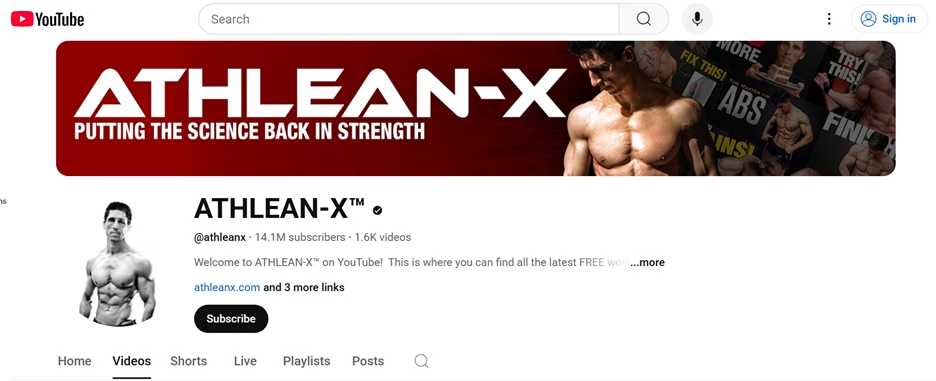
The Athlean-X vlog is a fitness channel that focuses on science-based workout programs and exercise tutorials, emphasizing proper form, injury prevention, and evidence-backed training methods for building muscle and strength.

Fun For Louis vlog creates upbeat lifestyle vlogs documenting his daily adventures, travels, and positive experiences while promoting an optimistic “live life to the fullest” mentality.
A vlog combines the best of video content and text-based blogs. If you can tell a story and engage your viewer, you’re well on your way to growing your audience.
What is a Content Strategy?
A content strategy is a comprehensive plan that guides the creation, development, distribution, and optimization of your content. Through your content strategy, your content achieves specific objectives and goals, meeting the needs of both potential and existing target audiences. A content marketing strategy provides the overarching framework for all content efforts, including video, blog, and social media.
Content strategies also help establish key tasks, such as writing guidelines for voice, tone, and format. These guidelines help ensure consistency and effectiveness across all content. Aligning your vlog with your overall marketing strategy ensures your video content supports your vlog’s growth and engagement goals.
Understanding Vlog Content Strategy Fundamentals
Now that you understand what a vlog is as well as a content strategy, it’s time to understand a vlog content strategy. With these fundamentals down, you’re well on your way to building an effective vlog content strategy.
Defining Your Vlog’s Core Purpose and Mission
First, you must define your core purpose and mission. You have to understand what your vlog is going to be and what its goals are. Are you going to be a travel vlogger showing your trip experiences? Are you a wedding videographer and vlog about the various weddings you cover? No matter who you are, it’s vital to understand what your purpose is. Think about how you can set your vlog apart from others.
To better understand your core purpose, develop a mission statement. A mission statement concisely and clearly explains your vlog content’s core mission and primary objectives you want the vlog to achieve. For example, if you’re creating a fitness vlog, you may note the following:
Core Mission Statement: To empower everyday people to build sustainable fitness habits and transform their lives through honest, relatable content that makes health and wellness accessible, enjoyable, and achievable for everyone, regardless of their starting point or fitness level.
Primary Objectives:
- Education and Empowerment: Provide practical, science-backed fitness advice and workout routines that viewers can easily implement in their daily lives, breaking down complex fitness concepts into understandable, actionable steps.
- Community Building: Foster a supportive, non-judgmental community where viewers feel motivated to share their fitness journeys, celebrate victories, and support each other through challenges and setbacks.
- Authenticity and Transparency: Document real fitness experiences, including struggles, plateaus, and failures alongside successes, to show that fitness is a journey with ups and downs rather than a perfect linear progression.
If your vlog is tied to an organization, it must align with your organization’s business objectives and goals. Whether your vlog’s goals are tied to you as a solopreneur or an organization, your goals must be developed with the following in mind:
- Audience growth
- Engagement
- Monetization
Having your core purpose, mission statement, and goals appropriately outlined establishes the most important building block of your vlog content strategy.
Audience Research and Persona Development for Vloggers
Once you’ve defined your vlog’s core purpose and goals, it’s time to define and understand your audience. To understand your audience, it’s essential to conduct research. Conducting thorough market research helps you gather data on audience demographics, preferences, and behaviors, which informs your content strategy.
Study Audience Analytics
Understanding your audience through comprehensive analytics is the key to any successful vlog content strategy. By conducting deep audience analysis using YouTube Analytics and social listening tools like Sprout Social and Buzzsumo, you gain invaluable insights into who your viewers are, what content resonates with them, and when they’re most active online. Additionally, analyzing data from your various social media accounts can further enhance your understanding of audience engagement across platforms.
Social listening tools complement platform analytics by revealing what your audience discusses beyond your channel. This strategic understanding transforms your content from generic videos into targeted, valuable experiences that drive higher engagement, longer watch times, and stronger community loyalty.
Develop an Audience Persona
Once you’ve analyzed your audience, including their demographics, content preferences, and search habits, it’s time to create an audience persona. An audience persona is a biographical chart that explains your core audience. The audience persona covers audience categories, including:
- Demographics
- Job Title and role
- Primary goals
- Pain points
- Content preferences
- Channel preferences
An audience persona is an excellent weapon in your arsenal because it will help you better understand your audience. An example of an audience persona chart is shown below:
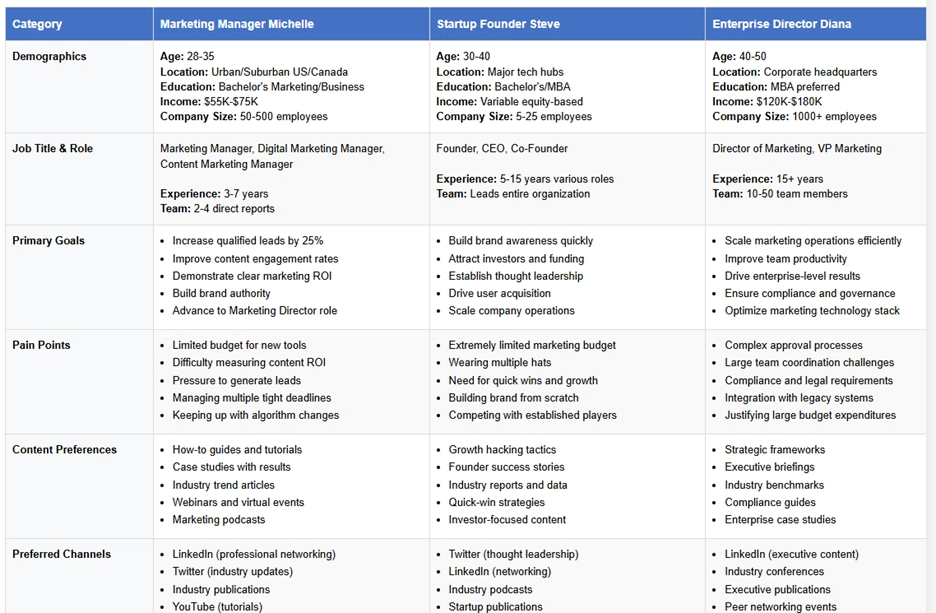
Once you’ve developed, reviewed, and approved your persona, you can leverage it to create a vlog that will resonate with your target audience.
Competitive Analysis and Market Positioning
The next step in this process is to perform a competitive analysis. A competitive analysis is a review of other competitors in your niche. For example, if you’re in the workout lifestyle niche, you would review both the top vlogs in the niche as well as the blogs at your current level.
Understanding the top vlogs and vlogs at your level within your niche will help you understand what vlogs at your level are doing and what you need to do to grow like the top vlogs. Through the analysis, you can also identify the following:
- Content gaps
- Opportunities for growth
- Content format and production style insights
- Monetization and partnership strategies
Reviewing your produced videos alongside competitors’ content can reveal what resonates with audiences and where improvements are needed. Additionally, incorporating user-generated content, such as customer reviews or testimonials, can help build trust and differentiate your vlog.
As you identify gaps and opportunities for growth, you can more easily develop a unique brand that reflects your personality, voice, and visual identity, differentiating it from other channels.
Once you’ve performed your analysis and identified gaps, you should next develop a process that allows you to stay current and ahead of the curve. Creating a competitive content matrix to track trends and inspiration sources will help achieve this goal. A competitive content matrix is a strategic analysis tool that organizes and compares content performance, themes, and strategies across multiple competitors. Below is an example of a content matrix for a fitness vlog.
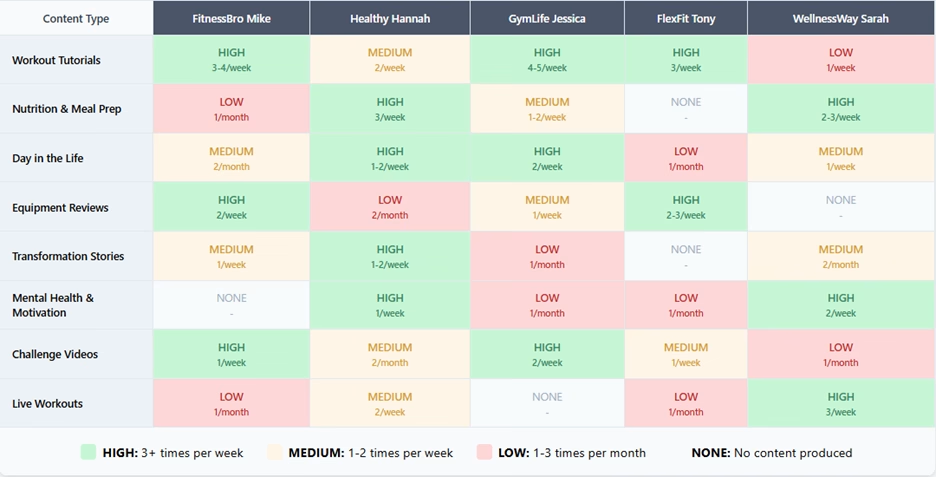
Keyword Research and Planning for Vloggers
An amazing video content strategy starts with understanding what your target audience is searching for. Keyword research is the backbone of any successful content strategy, helping you create video content that not only resonates with viewers but also gets discovered by a broader audience. By identifying relevant keywords and phrases with high search volume, you can tailor your vlog topics to match what people are actively looking for on search engines like Google and YouTube.
Start by using tools such as Google Keyword Planner, YouTube Keyword Planner, or your favorite SEO tool to uncover the terms your audience is searching for. Look for keywords that strike a balance between high search volume and moderate competition; these are your sweet spots for driving website traffic and boosting your marketing efforts.
Once you’ve gathered your list of relevant keywords, incorporate them naturally into your video titles, descriptions, and tags. This not only helps your videos rank higher in search engines but also increases the chances of your content being recommended to new viewers.
Remember, keyword research isn’t a one-time task; regularly revisit your keyword list to keep your content fresh and aligned with evolving audience interests. By making keyword research a core part of your video content strategy, you’ll consistently create content that attracts, engages, and grows your audience.
Developing Your Vlog Content Planning System
Once your preliminary work is done, it’s time to roll up your sleeves and begin developing a system that will help you build content in a timely, efficient, and consistent manner. Producing content efficiently requires a clear plan and collaboration, ensuring each video aligns with your overall strategy.
With your planning system in place, you can confidently start creating videos that support your vlog’s goals and objectives.
Content Pillar Strategy for Consistent Vlog Creation
Having a content pillar strategy is extremely important to the success of your vlog development process. Content pillars are the main topics you will cover in your vlog. From an organizational standpoint, all of your other content ties back to one or many of your pillars.
For example:

When developing your core content pillars, make sure they align with your expertise, interests, and your audience’s interests. Brainstorming content ideas for each pillar ensures a steady stream of relevant and engaging topics. Over time, you’ll be able to develop additional pillars based more on audience interests and trends, seasonal or otherwise. When you are starting, you should create 2-3 content pillars.
It’s important to note that when developing your vlog content, try to create a mix of educational, entertaining, and personal. For example:
- Educational and Entertaining: Create “Workout Fails & Fixes” videos where you humorously demonstrate common exercise mistakes.
- Personal and Educational: Share your own fitness journey struggles and breakthroughs while teaching viewers the specific strategies, nutrition tips, or training methods that helped you overcome challenges.
- Educational, Personal, and Entertaining: Film “A Day of Eating” vlogs where you cook healthy meals, share nutritional knowledge, tell personal stories about your relationship with food, and add entertaining elements like taste tests or cooking mishaps.
Video Content Calendar and Production Scheduling
Once your content has been decided, it’s time to develop a content calendar. The creation of a content calendar is vital to the success of your vlog because it dictates your production schedule. Your content calendar should also include social media posts to promote your videos and maintain audience engagement.
Planning your distribution channels ensures your content reaches the right audience on each platform. Staying on schedule is one of the most important aspects of having a vlog.

To use your content calendar to its fullest potential, you must create something manageable. You don’t want to overextend yourself by filling up your calendar with tasks. Be realistic with your assignments. If you’re only able to create five vlogs a month, include that in your schedule. Only scale up when you feel you’re ready.
Optimizing Vlog Content for Maximum Reach and Engagement
Developing a vlog and publishing it is one thing; reaching a large audience is an entirely different process to tackle. To reach a larger audience, you’ll need to develop and execute an outreach strategy.
YouTube SEO and Discoverability Strategies
Most people who post vlogs post them on YouTube. Currently, YouTube is 2nd most visited website in the world. Within the US, YouTube is the most popular social media platform, which brings it ahead of Facebook, Instagram, Pinterest, and TikTok.
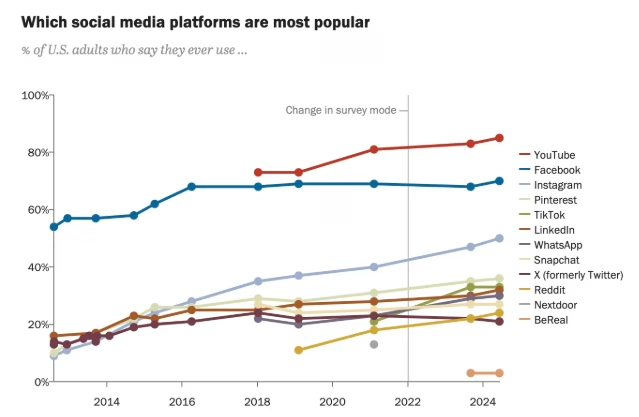
(Source – Pew Research Center)
One of the most important aspects of growing on YouTube is mastering keyword research. Other key SEO areas that help with growth include the following:
- Optimize vlog titles
- Vlog descriptions
- Keyword tags
- Vlog thumbnails
Performing these key SEO requirements for each vlog you post over time helps improve your search rankings and enhances the probability of being a recommended search option for people searching for vlogs in your niche.
As you implement these strategies, you should test how successful they are. A popular test to leverage is the A/B testing methodology.

Through A/B testing, you can test metrics like click-through rates.
Audience Engagement and Community Building Techniques
Building a thriving vlog community goes far beyond simply uploading videos; it requires intentional strategies that foster genuine connections and encourage active participation. The most successful vloggers understand that engagement isn’t just about numbers; it’s about creating meaningful relationships with viewers who become invested in your journey and content.
Developing Authentic Storytelling Techniques and Connections with Viewers
Authentic storytelling is your secret weapon for transforming casual viewers into devoted fans. Share your genuine experiences, including both triumphs and struggles, as this vulnerability creates relatability that resonates deeply with audiences. Focus on crafting narratives with clear beginnings, middles, and ends, while incorporating personal insights and lessons learned that viewers can apply to their own lives.
Implementing Effective Call-To-Actions
Strategic call-to-actions shouldn’t feel forced or salesy; they should feel like natural invitations to join the conversation. Ask specific questions that relate directly to your content, encouraging viewers to share their own experiences or opinions in the comments section. Time your subscription requests during your most engaging moments, and always explain the value viewers will receive by subscribing rather than simply asking them to hit the button.
Building and Nurturing a Loyal Community
Community building happens in the comments section, not just in your videos. Make it a priority to respond thoughtfully to comments, ask follow-up questions, and acknowledge your regular viewers by name when appropriate. Create recurring series or inside jokes that make your community feel like an exclusive club, and consider hosting live streams or Q&A sessions to provide real-time interaction opportunities that deepen those connections.
Cross-Platform Content Distribution and Repurposing
- Adapting vlog content for Instagram, TikTok, Twitter, and other social platforms
- Creating content repurposing workflows to maximize reach without additional production time
- Developing platform-specific optimization strategies for increased visibility and engagement
Measuring Success and Scaling Your Vlog Content Strategy
Once you’ve developed 1-2 months’ worth of vlogs, it’s time to begin measuring your performance. Use the insights from your analytics to plan and optimize your future content, ensuring your upcoming videos are even more engaging and effective.
Key Performance Indicators and Analytics Tracking
Before measuring your performance, you have to identify your key performance indicators (KPIs). KPIs are metrics that help confirm you are reaching your blog’s goals and objectives. For example, if you’re starting, one of your primary goals may be to reach 100 visitors per month after the first quarter.
Popular vlog KPIs to include in your metrics analysis should consist of:
- Click-through rates
- Views
- Watch time and average view duration
- Subscriber growth rate
- Engagement rate, including likes, comments, and shares
Your KPIs should be based on your objectives and goals. When setting up KPI goals, make sure they are attainable. For instance, when creating your vlog for the first time, it’s not advisable to set a goal of reaching 1,000 views within the first month.
Your goals should be SMART goals. SMART goals are defined as goals that are specific, measurable, achievable, relevant, and time-bound. The SMART goal-setting framework helps individuals and organizations create clear and attainable goals. They help prevent you from setting unattainable goals.
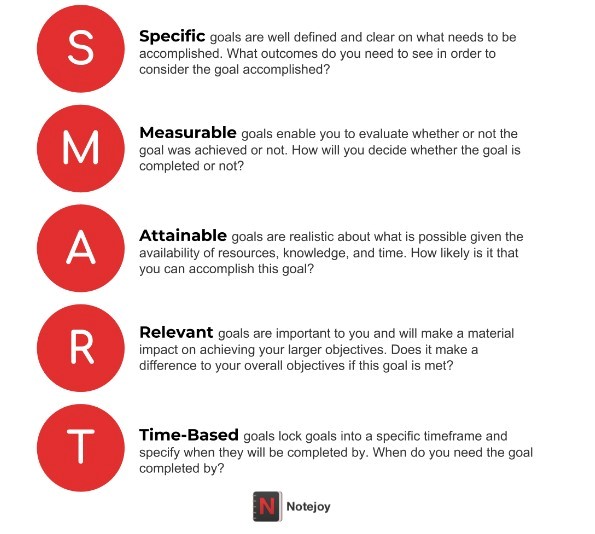
(Source – Notejoy)
Once your goals are set, you have to track your KPIs and metrics. When tracking, ensure you monitor all your online posts, including YouTube, TikTok, Instagram, and your website. Some places may be performing better than others.
To make KPI/metric analysis easier, it’s essential to build reports. Reports streamline metrics, making them more digestible for you and your organization to understand.

Common Mistakes to Avoid in Vlog Content Strategy
Even the most passionate vloggers can stumble if they overlook some common pitfalls in their content strategy. When developing your content
strategy, try to avoid the following:
- Failing to define your target audience clearly
- Inconsistency with content creation and deployment
- Quantity over quality
- Neglecting search engine optimization
By steering clear of these common mistakes, you’ll set your vlog up for sustainable growth, stronger engagement, and a loyal audience that keeps coming back for your next video.
Staying Up-to-Date with Industry Trends
The world of video content and social media platforms is constantly evolving, and staying ahead of the curve can make all the difference in your vlog’s success. To maintain a great video content strategy, it’s essential to keep your finger on the pulse of the latest trends in video content marketing, video marketing strategies, and content marketing best practices.
Here are some ways to stay updated with industry trends:
- Regularly reading blogs, industry publications, and thought leadership articles
- Participate in online communities
- Attend virtual or in-person events to network with other creators and marketers, exchanging insights and inspiration
Keep an eye on what’s trending across major social media platforms, whether it’s a new video format, a viral challenge, or a shift in audience preferences.
By incorporating ongoing learning into your content strategy, you can adapt quickly, experiment with new ideas, and keep your video content marketing efforts fresh and effective. Staying up-to-date isn’t just a nice-to-have it’s essential for building a vlog that thrives.
Conclusion
Creating a successful vlog content strategy isn’t about following someone else’s blueprint; it’s about understanding the fundamental principles and adapting them to your unique voice and audience. The strategies we’ve covered will help you build a sustainable, engaging video blog that grows with you over time.
Remember, consistency beats perfection. Start implementing these strategies one at a time, measure your results, and adjust based on what you learn about your audience. The vlogging world is waiting for your unique perspective and authentic voice.
If you’re ready to transform your vlog from a hobby into a strategic content powerhouse, start today. Your future audience is already searching for the content only you can create.